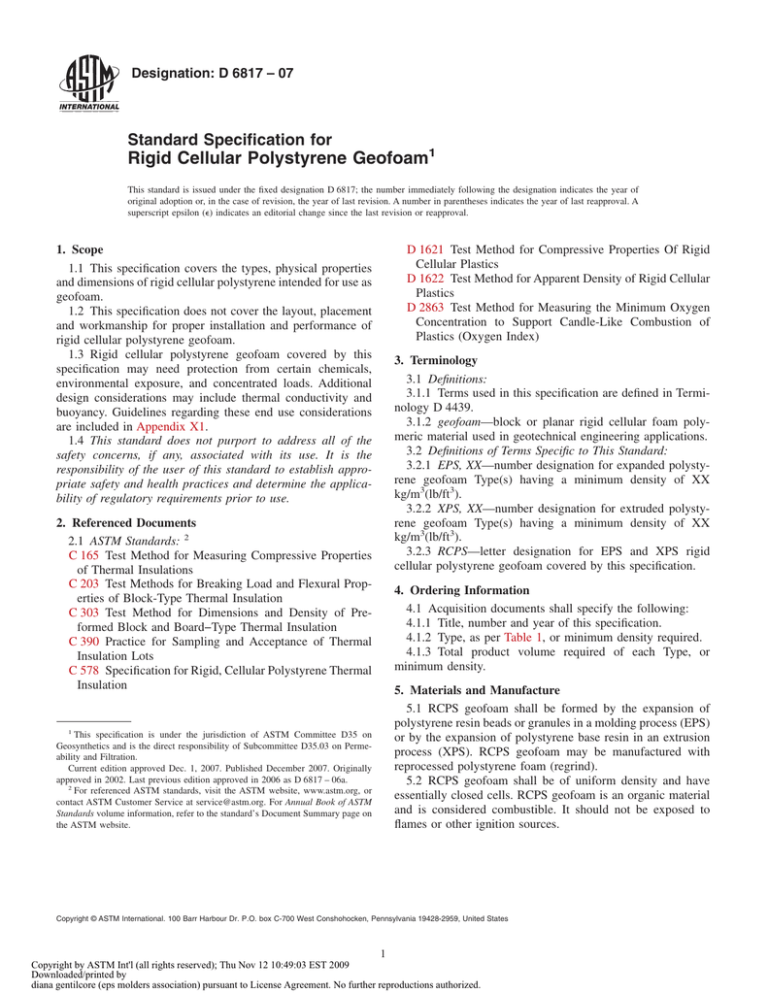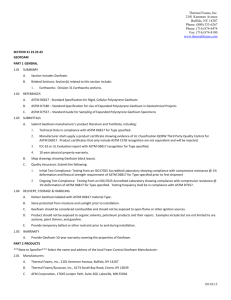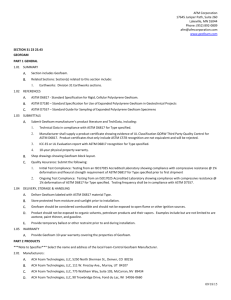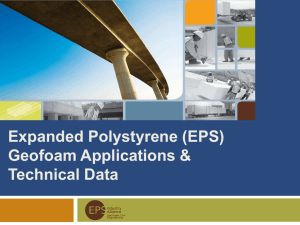
Designation: D 6817 – 07
Standard Specification for
Rigid Cellular Polystyrene Geofoam1
This standard is issued under the fixed designation D 6817; the number immediately following the designation indicates the year of
original adoption or, in the case of revision, the year of last revision. A number in parentheses indicates the year of last reapproval. A
superscript epsilon (e) indicates an editorial change since the last revision or reapproval.
1. Scope
1.1 This specification covers the types, physical properties
and dimensions of rigid cellular polystyrene intended for use as
geofoam.
1.2 This specification does not cover the layout, placement
and workmanship for proper installation and performance of
rigid cellular polystyrene geofoam.
1.3 Rigid cellular polystyrene geofoam covered by this
specification may need protection from certain chemicals,
environmental exposure, and concentrated loads. Additional
design considerations may include thermal conductivity and
buoyancy. Guidelines regarding these end use considerations
are included in Appendix X1.
1.4 This standard does not purport to address all of the
safety concerns, if any, associated with its use. It is the
responsibility of the user of this standard to establish appropriate safety and health practices and determine the applicability of regulatory requirements prior to use.
D 1621 Test Method for Compressive Properties Of Rigid
Cellular Plastics
D 1622 Test Method for Apparent Density of Rigid Cellular
Plastics
D 2863 Test Method for Measuring the Minimum Oxygen
Concentration to Support Candle-Like Combustion of
Plastics (Oxygen Index)
3. Terminology
3.1 Definitions:
3.1.1 Terms used in this specification are defined in Terminology D 4439.
3.1.2 geofoam—block or planar rigid cellular foam polymeric material used in geotechnical engineering applications.
3.2 Definitions of Terms Specific to This Standard:
3.2.1 EPS, XX—number designation for expanded polystyrene geofoam Type(s) having a minimum density of XX
kg/m3(lb/ft3).
3.2.2 XPS, XX—number designation for extruded polystyrene geofoam Type(s) having a minimum density of XX
kg/m3(lb/ft3).
3.2.3 RCPS—letter designation for EPS and XPS rigid
cellular polystyrene geofoam covered by this specification.
2. Referenced Documents
2.1 ASTM Standards: 2
C 165 Test Method for Measuring Compressive Properties
of Thermal Insulations
C 203 Test Methods for Breaking Load and Flexural Properties of Block-Type Thermal Insulation
C 303 Test Method for Dimensions and Density of Preformed Block and Board−Type Thermal Insulation
C 390 Practice for Sampling and Acceptance of Thermal
Insulation Lots
C 578 Specification for Rigid, Cellular Polystyrene Thermal
Insulation
4. Ordering Information
4.1 Acquisition documents shall specify the following:
4.1.1 Title, number and year of this specification.
4.1.2 Type, as per Table 1, or minimum density required.
4.1.3 Total product volume required of each Type, or
minimum density.
5. Materials and Manufacture
5.1 RCPS geofoam shall be formed by the expansion of
polystyrene resin beads or granules in a molding process (EPS)
or by the expansion of polystyrene base resin in an extrusion
process (XPS). RCPS geofoam may be manufactured with
reprocessed polystyrene foam (regrind).
5.2 RCPS geofoam shall be of uniform density and have
essentially closed cells. RCPS geofoam is an organic material
and is considered combustible. It should not be exposed to
flames or other ignition sources.
1
This specification is under the jurisdiction of ASTM Committee D35 on
Geosynthetics and is the direct responsibility of Subcommittee D35.03 on Permeability and Filtration.
Current edition approved Dec. 1, 2007. Published December 2007. Originally
approved in 2002. Last previous edition approved in 2006 as D 6817 – 06a.
2
For referenced ASTM standards, visit the ASTM website, www.astm.org, or
contact ASTM Customer Service at service@astm.org. For Annual Book of ASTM
Standards volume information, refer to the standard’s Document Summary page on
the ASTM website.
Copyright © ASTM International. 100 Barr Harbour Dr. P.O. box C-700 West Conshohocken, Pennsylvania 19428-2959, United States
1
Copyright by ASTM Int'l (all rights reserved); Thu Nov 12 10:49:03 EST 2009
Downloaded/printed by
diana gentilcore (eps molders association) pursuant to License Agreement. No further reproductions authorized.
55 (8.0)
70 (10.2)
172 (25.0)
24.0
35 (5.1)
40 (5.8)
69 (10.0)
24.0
B
EPS19
24.0
207 (30.0)
110 (16.0)
90 (13.1)
40 (5.8)
18.4 (1.15)
EPS22
24.0
276 (40.0)
135 (19.6)
115 (16.7)
50 (7.3)
21.6 (1.35)
EPS29
24.0
345 (50.0)
200 (29.0)
170 (24.7)
75 (10.9)
28.8 (1.80)
EPS39
24.0
414 (60.0)
276(40.0)
241 (35.0)
103 (15.0)
38.4 (2.40)
EPS46
24.0
517 (75.0)
345 (50)
300 (43.5)
128 (18.6)
45.7 (2.85)
XPS20
24.0
276 (40.0)
104 (15.0)
85 (12.3)
20 (2.9)
19.2 (1.20)
XPS21
24.0
276 (40.0)
104 (15.0)
110 (16.0)
35 (5.1)
20.8 (1.30)
XPS26
24.0
345 (50.0)
173 (25.0)
185 (26.8)
75 (10.9)
25.6 (1.60)
XPS29
24.0
414 (60.0)
276 (40.0)
235 (34.1)
105 (15.2)
28.8 (1.80)
If yield occurs prior to 10% deformation, report compressive resistance and deformation at yield in addition to the compressive resistance at 1%, 5% and 10% deformation.
For products that have an external skin, testing shall be undertaken with skins intact.
25 (3.6)
15 (2.2)
A
EPS15
14.4 (0.90)
EPS12
11.2 (0.70)
Type
Density, min.,
kg/m3(lb/ft3)
Compressive Resistance, min.,
kPa (psi) at 1 %
Compressive Resistance, min.,
kPa (psi) at 5 %
Compressive Resistance, min.,
kPa (psi) at 10 %A
Flexural Strength, min.,
kPa (psi)
Oxygen index, min.,
volume %
TABLE 1 Physical Property Requirements of RCPS GeofoamA,B
XPS36
24.0
517 (75.0)
414 (60.0)
335 (48.6)
160 (23.2)
35.2 (2.20)
XPS48
24.0
689 (100.0)
690 (100.0)
535 (77.6)
280 (40.6)
48.0 (3.00)
D 6817 – 07
Copyright by ASTM Int'l (all rights reserved); Thu Nov 12 10:49:03 EST 2009
Downloaded/printed by
diana gentilcore (eps molders association) pursuant to License Agreement. No further reproductions authorized.
2
D 6817 – 07
6. Qualification Requirements
6.1 The physical properties listed in Table 1 constitute the
minimum product qualification requirements for commonly
manufactured types of RCPS geofoam.
6.2 RCPS Geofoam Types—It is the users responsibility to
specify the required Type as in Table 1 and to obtain supporting
documentation regarding physical properties from the material
supplier.
6.3 Combustibility Requirements—All RCPS geofoam shall
contain sufficient flame retardants to meet a minimum Oxygen
Index as required in Table 1.
6.4 Curing—Unless otherwise specified in the contract,
RCPS geofoam shall be cured for a minimum of 24 h before
delivery and inspection.
9.2 Weight—Determine the weight of selected full size units
in accordance with Test Method D 1622, or as specified.
9.3 Dimensions—Verify specified dimensions and tolerances, as prescribed in Test Method D 1622 and 7.2 of this
specification.
9.4 Density—Compute the density of test samples in accordance with Test Method D 1622.
10. Acceptance or Rejection
10.1 Material that fails to conform to this specification shall
be rejected promptly in writing. The manufacturer or supplier
shall have the right to re-inspect the rejected shipment and
resubmit selected units for acceptance under tightened inspection.
7. Availability and Dimensional Tolerance
7.1 Availability—The RCPS geofoam materials covered by
this specification are commonly available in the size range
shown in Table 2. Specific RCPS geofoam block dimensions
vary by manufacturer equipment characteristics.
7.2 Dimensional Tolerance—Unless otherwise specified,
the acceptable length, width, thickness, flatness and squareness
tolerance criteria on RCPS geofoam shall not exceed 6 0.5 %.
11. Certification
11.1 Unless otherwise specified in the purchase order or
contract, the manufacturer or supplier shall furnish third party
certification that representative material has either been tested
or inspected as directed in the specification and the requirements have been met. When specified in the purchase order or
contract, a report of the test results shall be furnished.
8. Damage and Degradation
8.1 Damage—RCPS geofoam as delivered to the project
site shall have no defects that will adversely affect its service
and workability qualities. Material units that manifest unacceptable surface or volumetric damage shall be replaced.
8.1.1 Surface Damage—Damage to load bearing RCPS
geofoam surfaces shall be limited to less than 20 % of the
equivalent load bearing area of the unit.
8.1.2 Volume Damage—Volumetric damage of RCPS geofoam shall be limited to less than 1 % of the volume of a single
unit.
8.1.3 UV (Ultra-Violet) Degradation—Discoloration and
dusting of RCPS geofoam caused by the extensive exposure to
sunlight is a defect that will adversely affect its service and is
grounds for rejection. Refer to X1.6.
12. Product Marking
12.1 The following shall be marked on each whole unit of
product:
12.1.1 Manufacturers Identification,
12.1.2 Date of Manufacture,
12.1.3 Type, (See Table 1), and
12.1.4 Weight, or Density.
13. Test Methods
13.1 Dimensions and Density—Test in accordance with Test
Method C 303 or Test Method D 1622.
13.2 Compressive Resistance—Test in accordance with Test
Method C 165 or Test Method D 1621 using 50 mm (2 in.)
cubes. The rate of cross-head movement shall be 5.0 6 0.5
mm/min (0.2 6 0.02 in/min) equivalent to 10 % strain per
minute.
13.3 Flexural Strength—Test in accordance with Test
Method C 203.
13.4 Oxygen Index—Test in accordance with Test Method
D 2863.
9. Inspection
9.1 Sampling—Unless otherwise specified in the purchase
order or contract, the material shall be sampled for inspection
in accordance with Criteria C 390.
TABLE 2 Common Manufactured Dimensions of RCPS Geofoam
Dimension, mm (in.)
Width
Length
Thickness
All EPS Types
All XPS Types
305 to 1219 (12 to 48)
1219 to 4877 (48 to 192)
25 to 1219 (1 to 48)
406 to 1219 (16 to 48)
1219 to 2743 (48 to 108)
25 to 102 (1 to 4)
14. Keywords
14.1 block; board; cellular polystyrene; EPS; expanded
polystyrene; extruded polystyrene; foam plastic; geofoam;
RCPS; reprocessed; rigid cellular polystyrene; XPS
3
Copyright by ASTM Int'l (all rights reserved); Thu Nov 12 10:49:03 EST 2009
Downloaded/printed by
diana gentilcore (eps molders association) pursuant to License Agreement. No further reproductions authorized.
D 6817 – 07
APPENDIX
(Nonmandatory Information)
X1. END-USE CONSIDERATIONS
X1.4 Buoyancy
X1.1 Thermal Resistance
X1.1.1 RCPS geofoam also functions as a thermal insulation. The thermal insulation properties of RCPS geofoam are as
specified in Specification C 578, and may impact the end use
design of applications subject to different exposure conditions.
Consult the RCPS geofoam manufacturer for specific recommendations.
X1.4.1 RCPS geofoam becomes buoyant when submerged
in water and adequate ballast must be provided to resist
expected uplift forces.
X1.5 Design
X1.5.1 The design and installation of RCPS geofoam is the
responsibility of the user.
X1.5.2 RCPS geofoam can be supplied precut to specified
dimensions to fit specific project needs. Desired shapes and
sizes can also be field cut with a hot wire, saw, or other cutting
tool.
X1.2 Solvent Exposure
X1.2.1 RCPS geofoam must be protected from petroleum
based solvents and their vapors. Examples of these solvents
are: gasoline, diesel fuel, concrete curing compound, coal tar
pitch, and asphaltic mastic compounds.
X1.3 Equipment Traffic
X1.3.1 Equipment traffic that can impose contact pressures
in excess of the allowable design stress for RCPS geofoam
should be restricted. Protective materials such as sheathing or
planks may be placed on the material to allow light rubber-tired
equipment use.
X1.6 Ultra-Violet Degradation
X1.6.1 Discoloration and dusting of load bearing surfaces
of RCPS geofoam caused by extended exposure to sunlight
shall be removed by pressure washing.
ASTM International takes no position respecting the validity of any patent rights asserted in connection with any item mentioned
in this standard. Users of this standard are expressly advised that determination of the validity of any such patent rights, and the risk
of infringement of such rights, are entirely their own responsibility.
This standard is subject to revision at any time by the responsible technical committee and must be reviewed every five years and
if not revised, either reapproved or withdrawn. Your comments are invited either for revision of this standard or for additional standards
and should be addressed to ASTM International Headquarters. Your comments will receive careful consideration at a meeting of the
responsible technical committee, which you may attend. If you feel that your comments have not received a fair hearing you should
make your views known to the ASTM Committee on Standards, at the address shown below.
This standard is copyrighted by ASTM International, 100 Barr Harbor Drive, PO Box C700, West Conshohocken, PA 19428-2959,
United States. Individual reprints (single or multiple copies) of this standard may be obtained by contacting ASTM at the above
address or at 610-832-9585 (phone), 610-832-9555 (fax), or service@astm.org (e-mail); or through the ASTM website
(www.astm.org).
4
Copyright by ASTM Int'l (all rights reserved); Thu Nov 12 10:49:03 EST 2009
Downloaded/printed by
diana gentilcore (eps molders association) pursuant to License Agreement. No further reproductions authorized.





